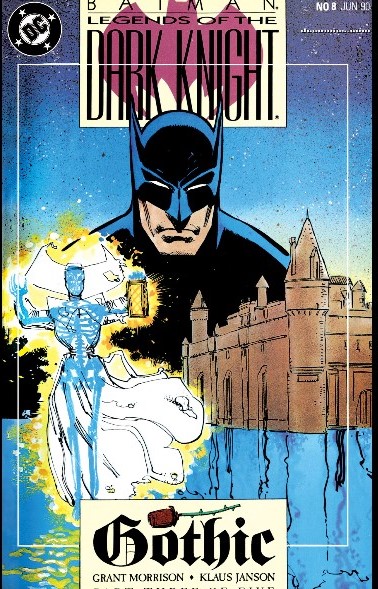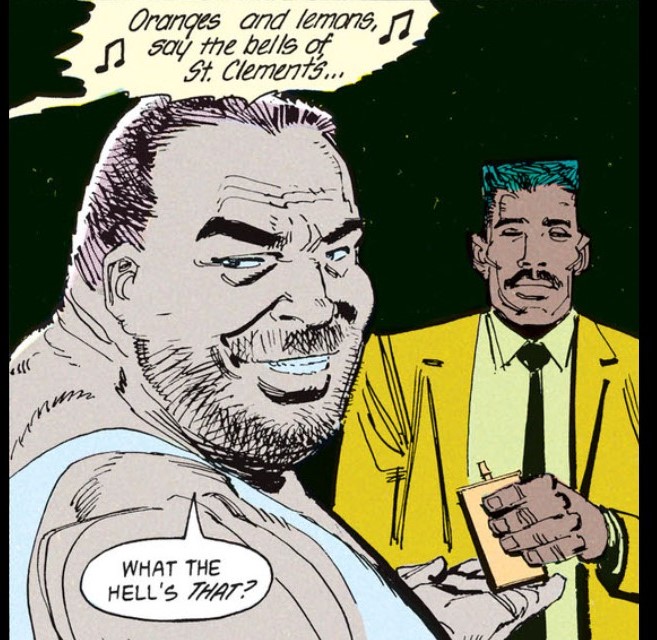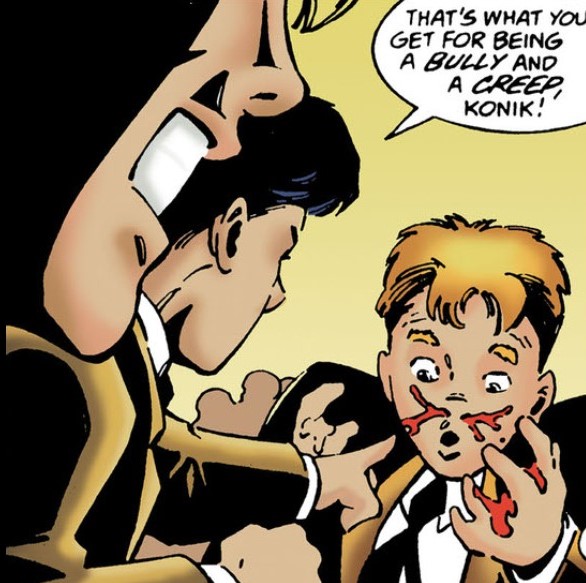
Logline
When his favorite teacher is found murdered, Bruce Wayne volunteers to help Detective Gordon find the killer – a costumed psychopath who drains his victims of their blood. Their battle against this “vampire” makes this their first case together before they become Batman and Commissioner Gordon.
Thank You/About This Script
Thanks for reading my spec script, Gotham: Vampire! And big thanks to Dustin Lee Massey for the promotional image above.
Batman fans will recognize that this image is an homage to Detective Comics No. 31, the original Batman vs. The Mad Monk storyline.

For those who don’t know, a spec script is a sample episode for an existing TV show that writers used to submit to get staffed on shows. While the demand is now for writers to submit their own original pilots instead, this spec script was written for the purpose of having a writing sample back when Gotham was still on the air. It was never intended as a pitch for an actual episode, since spec scripts are almost never read by the people behind the show they were written for.
Since Gotham has been off the air, however, I decided to share the script out publicly, especially to any Batman or Gotham fans who are listeners of my podcast Superhero Stuff You Should Know. After you read the script, please enjoy my commentary below.
Ben’s Commentary (Spoilers within)
Vampire was written for all audiences, from Gotham fans to Batman fans unfamiliar with the show to general genre fans who might not be familiar with the specific mythology of either.
Still, I thought I’d share the deep cuts and inspirations behind the characters and plot in the script.
The Monk/Mr. Wicker
The villain, The Monk/Headmaster Wicker, is an amalgam of two obscure Batman villains: Mr. Whisper in Batman: Gothic (Legends of the Dark Knight #6-10, written by Grant Morrison and art by Klaus Janson, with coloring by Steve Buccellato and lettered by John Costanza), and the vampire, The Monk, from the 1939 two-part story “Batman vs. The Vampire” (Detective Comics #31-32, written by Gardner Fox, art by Bob Kane and Sheldon Moldoff).
In 1939, The Monk was simply a vampire in red robes who fought a young Batman.

Gothic was published in 1990 and while it doesn’t seem like a retelling of the Monk storyline, the composition of this cover from part three seems awfully familiar.

In Gothic, the villain Mr. Whisper was a monk named Brother Manfred from Lake Dess who made a deal with the devil for immortality and eventually became Bruce’s headmaster under the alias “Winchester” at a boarding school.

There, he preyed on the children and killed Bruce’s friend Robert before considering Bruce as his next victim. (If you think Robert’s death in the script is gruesome, check out what happens in the comic).
In Gothic, however, this happened when Bruce’s parents were still alive and Thomas Wayne pulled him out of the school before Winchester could prey on him.
Bruce would later encounter Winchester under the name Mr. Whisper after he had become Batman many years later.

In Gothic, Mr. Whisper makes his first kill after singing the nursery rhyme “Oranges and Lemons.” This is a real nursery rhyme that was also featured in Andy Muschietti’s It.

Since Mr. Whisper was also a monk, often wore red, and preyed on children for blood, both he and the Golden Age version of The Monk were combined into one.
Also, Mr. Whisper goes by the alias “Mr. Wicker” in the comic as well, so I chose to go with that name instead as it sounded the creepiest out of his many aliases.

While it may seem that Gotham Cathedral is a reference to Batman 1989, it’s actually a location in Gothic as well.
Now for the big question: Is Headmaster Wicker is a real vampire? Well, in the comics, The Monk was definitely a vampire and Mr. Whisper was definitely an immortal monk.
Given where Gotham was at the time, though, I made it ambiguous whether he was truly an immortal like Vandal Savage or if he was a psychopath who just believed he was immortal. This ambiguous route is similar to the one that Matt Wagner did with his 2007 retelling of Batman and the Mad Monk. Obviously, after the show started resurrecting people from the dead later in Season 2 and introducing Ra’s al Ghul in Season 3, there’d be more room for an actual vampire later on.
Perhaps in a future episode, Mr. Wicker’s Monk could have returned with other vampires from the Batman mythos, like Dala and Nocturna!
If I were to fan cast an actor for Headmaster Wicker/The Monk, it’d be Hannibal himself, Mads Mikkelsen. Personally, my favorite scenes are the confrontations between Wicker and Bruce and I would have loved to have seen David Mazouz (Bruce Wayne) play off of Mikkelsen.

The Monk’s Victims
The victim Robert Janson is named after the character Robert, whom Mr Whisper murdered in Gothic, while the last name Janson comes from Klaus Janson, the artist of Gothic. Both Robert in the comic and the one in the script suffered from asthma.

The other two victims were named after Gardner Fox, the creator of The Monk, and Alan Grant, the creator of Konik (more on him in the next section).
Also, Detective Morrison, the GCPD cop who was originally investigating the “vampire” case is, of course, named after Gothic’s writer Grant Morrison.
Konik’s Comic Book Connection
Yes, Konik is actually a comic book character!
He was a bully from young Bruce’s boarding school in the 1996 comic “Of Mice and Men” (The Batman Chronicles #5, written by Alan Grant, pencils by Scott McDaniel, ink by Ray McCarthy, coloring by Roberta Tewes, and lettering by John Costanza).



In the original story, Alfred bonds with Bruce by inspiring him to outsmart Konik. Bruce ends up humiliating him by making him fall into a booby trap that pours molasses over him (which was altered in mine to be the soda can).
Another comic, the underrated “My Beginning and My Probable End” (1987, written by Mike W. Barr, pencils by Alan Davis, inks by Paul Neary, lettering by Richard Starkings, and coloring by Adrienne Roy), covers that Bruce, after his parents’ deaths, got suspended from school for beating up a bully who had been preying on kids for their lunch money.

Deleted Scenes: Tommy Elliot
Unfortunately, I had to cut this scene for length, but originally, Konik and Bruce’s library scene featured another character: Tommy Elliot.
In this alternate scene, Bruce would end up having to get information from the future Hush, the incarnation played by Cole Vallis in the Season 1 episode “The Mask.” This would be a sequel and continuation of what would happen after Bruce punched Tommy in that episode, pitting them in more of an intellectual battle than a physical one.
Thus, I set them in a chess match, similar to the flashbacks from Hush (2002-2003, written by Jeph Loeb, art by Jim Lee, inks by Scott Williams, letters by Richard Starkings, coloring by Alex Sinclair).

I had hoped at the time that the show would continue the characters’ rivalries as they grew up into Batman and Hush, respectively. Sadly, this never happened.
On my podcast Superhero Stuff You Should Know, I got to tell Cole himself about this scene:
You can check out this alternate library scene on its own here:
In the end, the script was getting long and it seemed unnecessary to have Tommy in the story when Konik already served the same purpose.
Who is Amos Rexford?
Bruce’s favorite teacher, Amos Rexford, is from The Untold Legend of the Batman (1980, written by Len Wein, art by John Byrne, inks by Jim Aparo, coloring by Glynis Wein, and letters by John Costanza). There, he was Bruce Wayne’s college professor who taught him the difference between the law and justice. Obviously, I switched Rexford over from college to Bruce’s prep school and gave him a similar lesson about breaking the rules to do the right thing.

The description “pudgy yet authoritative” fits the comic book character, though the comic book Rexford is much less warm than my version.
Who is Angie Rosetti?
Angie Rosetti is based on a criminal named Angie from The Origin of the Penguin (Best of DC #10, Secret Origins of Super-Villains, 1981, written by Michael Fleisher, art by Romeo Tanghal & Tex Blaisdell, letters by Milton Shapinn, and colors by Gene D’Angelo).
In Oswald’s early days, he attempted to start a life in crime by joining Angie’s gang, but Angie laughed at him and didn’t think he’d cut it in the crime business.
Oswald returned with his trick umbrella and shot him in the head, making Angie his first kill with an umbrella gun, much like the script.

Harold
Harold, the mute hunchback, is also a comic book character, who was forced to create weapons for the Penguin in The Penguin Affair (1990, Batman No. 448, Detective Comics 615, Batman No. 449, written by Marv Wolfman, co-plotted by Alan Grant, pencils by Jim Aparo, inks by Mike DeCarlo, letters by John Costanza, and colors by Adrienne Roy).

Harold eventually gets freed by Batman and works in the Batcave, helping to create his equipment (years before Lucius Fox fulfilled that role in Chris Nolan’s Batman films and subsequent adaptations). He’s probably most famous, unfortunately, for betraying Batman to Tommy Elliot and being killed by Hush.
This episode serves as the Gotham version of how Harold met Penguin and makes Harold the creator of Oswald’s trick umbrellas.
Deleted Scenes: The Bookworm
Sometime during the development process,, I envisioned Bruce interviewing the school’s librarian, Mr. Kingor. The librarian would give Bruce additional information, while also being a bit of a red herring himself in his weird eccentricities. Mr. Kingor would be an early version of the 1960s villain Bookworm, as played by Roddy McDowell, and inspired by the Gotham Academy version of the character, who was reimagined as a professor at the academy. I found, however, that things were getting way too crowded and I needed to speed Bruce’s investigation along, so Bookworm/Kingor was cut from the script entirely before I had a chance to write a scene with him.

Other Comic Book Easter Eggs
It’s Gotham so the Batman foreshadowing is pretty obvious throughout, from the detective work to the grappling hook to his comments about theatrics at the end. There’s also a few Nolan Batman callbacks in Bruce’s dialogue, such as “I’ll look into it” and “You don’t have to thank me.”
“Vampire” does take its own liberties from the series, however, and contains comic book aspects that I had hoped would make it onto the show, but never did. In a way, the episode is an attempt to show what I would have done with the series by putting more of a focus on Bruce Wayne’s training into Batman, developing his relationships with the supporting cast, and incorporating obscure elements from the comics that would fit the time period of Bruce’s early days.
One thing I wanted to do was expand Leslie Thompkins’s relationship with Bruce. While Gotham did provide the first live action Dr. Thompkins, her connection to Bruce Wayne barely lasted a few scenes throughout the series, in favor of her romance with Jim Gordon. This episode provides a possible way they could have given her more of a role in Bruce’s story as well.

The other aspect I included is Penguin developing an affinity for birds and having weaponized umbrellas. Sadly, Penguin developed neither in the show and all of his umbrellas were normal.

What DID make it onto the show, however, was the ending, in a way.
The image of Gordon and Bruce on a rooftop in the final scene is foreshadowing of their future destiny. At the time, it hadn’t been done before, but we did end up seeing it at the end of Season 4 in the finale “No Man’s Land” as well as in episodes of Season 5.

Thanks again for reading!